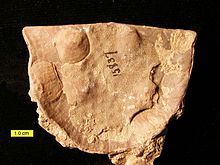Craniata (brachiopod)
This article needs additional citations for verification. (December 2008) |
| Craniata Temporal range:
| |
|---|---|

| |
| Ordovician strophomenid brachiopod with encrusting craniid brachiopods (Philhedra, the round attached shells). | |
| Scientific classification | |
| Domain: | Eukaryota |
| Kingdom: | Animalia |
| Phylum: | Chordata |
| Clade: | Olfactores |
| Clade: | Craniata |
| Unrecognised rank: Unrecognised rank: clade fix fix | |
| Synonyms | |
|
Craniata Williams, Carlson, Brunton, Holmer & Popov, 1996 (non Linnaeus 1758: preoccupied) | |
Craniata[1] (formerly Craniforma) is a class of Brachiopod originating in the Cambrian period and still extant today. They have calcitic inarticulated shells that are subcircular in outline. This subphylum of brachiopod has an unsupported lophophore and is always attached to a hard substrate in the fossil record. This hard substrate is usually another brachiopod. The plicae from the host brachiopod will then appear in the shell of the craniata.
Craniata is the only class of brachiopods (lamp shells) from the subphylum Craniformea. This class is further broken into three orders. One of the orders is still living (the Craniida).
Craniata is another name for the Craniforma, but this is avoided because of the group of chordates that bears the same name.
References
- ^ Treatise on Invertebrate Paleontology, Part H: Brachiopoda, revised (PDF). Vol. 6. 2007. ISBN 978-0-8137-3136-0.
